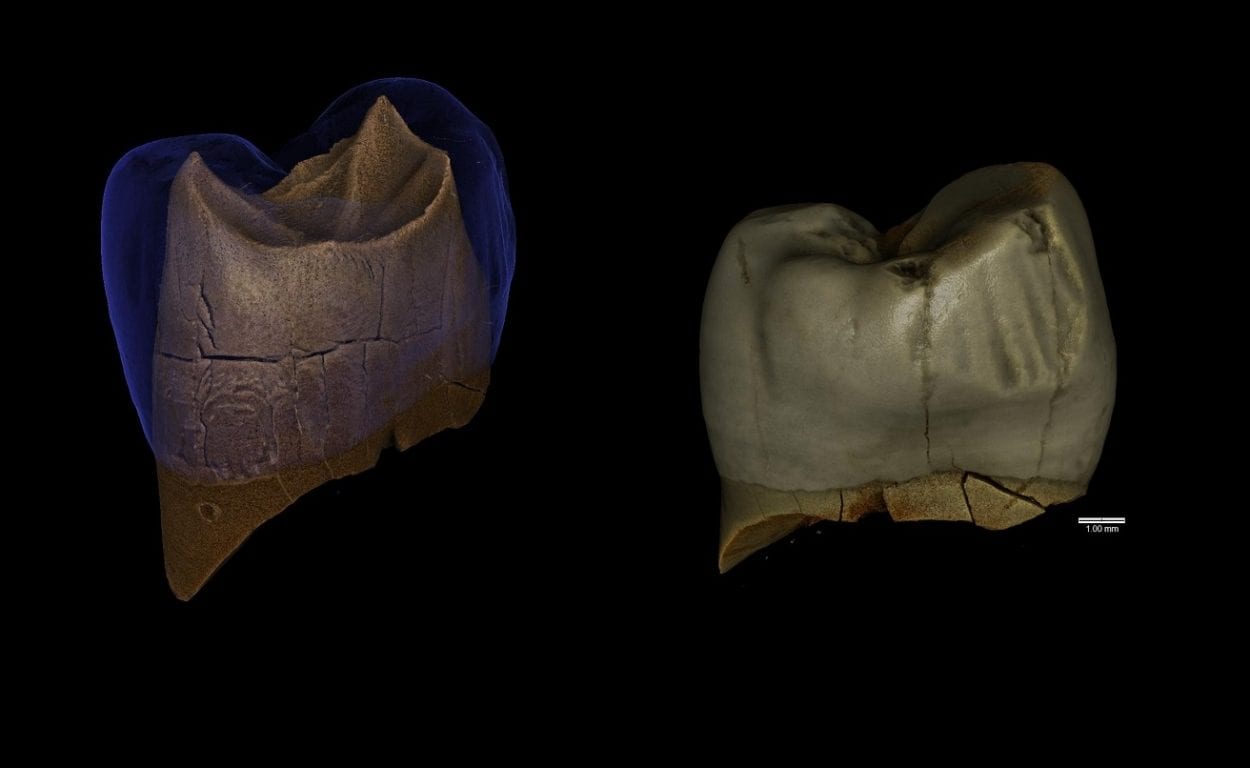Neanderthals from around 46,000 years ago used ‘toothpicks and oral hygiene’ an international team of scientists have found.
Analysing two teeth excavated from the Pleistocene layers of the Stajnia Cave (Kraków-Częstochowa Upland), the team led by Dr. Wioletta Nowaczewska from the Department of Human Biology, University of Wrocław, found traces left by a toothpick.
She said: “It appears that the owner of the tooth used oral hygiene. Probably between the last two teeth there were food residues that had to be removed. We don’t know what he made a toothpick from – a piece of a twig, a piece of bone or fish bone. It had to be fairly stiff, cylindrical object, which the individual used often enough to leave a clear trace.”
This is the second known example of such hygienic procedures being practiced by Neanderthals from Stajnia Cave. Similar traces have been preserved on another tooth found earlier in the cave.
Scientists also believe that the teeth, a wisdom tooth (third lower molar) and an upper premolar, belonged to an individual over 30 years old, and the other to a slightly younger male in his twenties.
However, they found no pathological changes indicative of enamel growth disorders, hypoplasia or caries. They note that the wisdom tooth shows signs of severe wear, which may be related to eating hard food.
To determine whether the tooth belonged to our immediate ancestor (Homo sapiens) or a fossil relative (Homo neanderthalensis), scientists assessed the structure of the tooth’s crown, enamel thickness, dentine surface contour and crown surface microtrauma.
They compared the data with other data on the teeth of Neanderthals, as well as fossil and contemporary representatives of our species.
Dr. Nowaczewska said: “A set of features, i.e. the presence of a specific combination of features characteristic of Neanderthals indicates that further teeth from Stajnia Cave belonged to them. In the case of the lower molar, one can see a complicated structure: a large number of tubercles. In the front part of the crown there was also a characteristic depression and enamel formation.
“The good condition of the premolar allowed us to carry out 2D and 3D analysis of enamel thickness, digital reconstruction, virtual ‘pulling’ of the enamel cap and assessment of enamel thickness, which in Neanderthals is thinner than in H. sapiens. All these features taken together point to Neanderthals.”
The teeth were initially discovered in 2010 along with numerous remains of the fauna during excavation works conducted under the supervision of Dr. Mikołaj Urbanowski.
But it is only recently that they have been analysed using mitochondrial DNA. Dr. Mateja Hajdinjak from the Max Planck Institute for Evolutionary Anthropology the tests along with additional analyses to confirm that the teeth belonged to Neanderthals.
Neanderthal bone remains are rare finds in Central and Eastern Europe (there are slightly more sites related to Neanderthal tools). In today’s Poland, such finds accumulate in the south; northern Poland remained within the reach of the glacier for a long time and the conditions for survival were difficult.
Officially confirmed discoveries are few and small in size: four teeth. Three of them were also discovered in Stajnia Cave, one in Ciemna Cave (also in the Kraków-Częstochowa Upland).
Dr. Nowaczewska believes that this is not the end of the discoveries in the Kraków-Częstochowa Upland. She said: “When I look at these areas as a palaeoanthropologist, I have the impression that time stands still there… If there are still any Neanderthal bone remains to be found, the search should focus on the Upland and other southern sites. Due to the then climatic conditions, this was the area with the best living conditions.”
The study was carried out by scientists from the University of Wrocław and the University of Silesia, the Institute of Systematics and Evolution of Animals of the Polish Academy of Sciences, the Polish Geological Institute, the University of Bologna (Italy), the Natural History Museum in London (Great Britain), the Max Planck Institute for Evolutionary Anthropology (Germany). The results were presented in the Journal of Human Evolution.
Virtual tooth models were prepared by Dr. Marcin Binkowski from the University of Silesia, with the technical support of Michał Walczak and Martyna Czaja, as well as Professor Stefano Benazzi and Antonino Vazzana from the University of Bologna.
PAP – Science in Poland, Anna Ślązak
Header Image Credit : M. Binkowski





